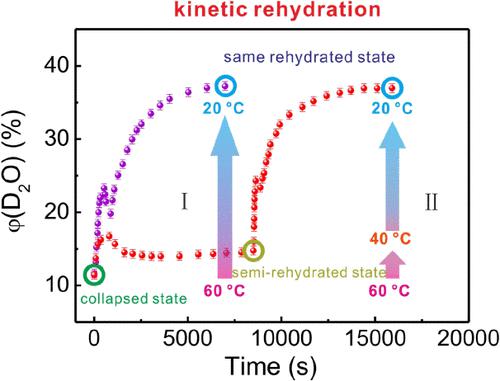Our official English website, www.x-mol.net, welcomes your
feedback! (Note: you will need to create a separate account there.)
Effect of Thermal Stimulus on Kinetic Rehydration of Thermoresponsive Poly(diethylene glycol monomethyl ether methacrylate)-block-poly(poly(ethylene glycol) methyl ether methacrylate) Thin Films Probed by In Situ Neutron Reflectivity
Langmuir ( IF 3.7 ) Pub Date : 2022-06-22 , DOI: 10.1021/acs.langmuir.2c00940 Neng Hu 1 , Lei Mi 1 , Ezzeldin Metwalli 2 , Lorenz Bießmann 2 , Christian Herold 2 , Robert Cubitt 3 , Qi Zhong 1, 2 , Peter Müller-Buschbaum 2, 4
Langmuir ( IF 3.7 ) Pub Date : 2022-06-22 , DOI: 10.1021/acs.langmuir.2c00940 Neng Hu 1 , Lei Mi 1 , Ezzeldin Metwalli 2 , Lorenz Bießmann 2 , Christian Herold 2 , Robert Cubitt 3 , Qi Zhong 1, 2 , Peter Müller-Buschbaum 2, 4
Affiliation

|
The kinetic rehydration of thin di-block copolymer poly(diethylene glycol monomethyl ether methacrylate)-block-poly(poly(ethylene glycol) methyl ether methacrylate) (PO2-b-PO300) films containing two thermoresponsive components is probed by in situ neutron reflectivity (NR) with different thermal stimuli in the D2O vapor atmosphere. The transition temperatures (TTs) of PO2 and PO300 blocks are 25 and 60 °C, respectively. After the one-step stimulus (rapid decrease in temperature from 60 to 20 °C), the film directly switches from a collapsed to a fully swollen state. The rehydration process is divided into four steps: (a) D2O condensation, (b) D2O absorption, (c) D2O evaporation, and (d) film reswelling. However, the film presents a different rehydration behavior when the thermal stimulus is separated into two smaller steps (first decrease from 60 to 40 °C and then to 20 °C). The film first switches from a collapsed to a semiswollen state caused by the rehydrated PO300 blocks after the first step of thermal stimulus (60 to 40 °C) and then to a swollen state induced by the rehydrated PO2 blocks after the second step (40 to 20 °C). Thus, the kinetic responses are distinct from that after the one-step thermal stimulus. Both the time and extent of condensation as well as evaporation processes are significantly reduced in these two smaller steps. However, the final states of the rehydrated PO2-b-PO300 films are basically identical irrespective of the applied thermal stimulus. Thus, the final state of thermoresponsive di-block copolymer films is not affected by the external thermal stimuli, which is beneficial for the design and preparation of sensors or switches based on thermoresponsive polymer films.
中文翻译:

原位中子反射率探测热刺激对热响应型聚(二甘醇单甲醚甲基丙烯酸酯)-嵌段-聚(聚(乙二醇)甲基醚甲基丙烯酸酯)薄膜动力学再水化的影响
原位研究了含有两种热敏组分的二嵌段共聚物聚(二甘醇单甲醚甲基丙烯酸酯)-嵌段-聚(聚(乙二醇)甲基醚甲基丙烯酸酯)(PO 2 - b -PO 300 )薄膜的动力学再水化。 D 2 O 蒸气大气中不同热刺激的中子反射率 (NR) 。PO 2和 PO 300嵌段的转变温度 (TT)分别为 25 和 60 °C。在一步刺激(温度从 60 到 20°C 迅速下降)后,薄膜直接从塌陷状态转变为完全膨胀状态。复水过程分为四个步骤: (a) D 2O冷凝,(b) D 2 O吸收,(c) D 2 O蒸发,和(d)薄膜再溶胀。然而,当热刺激分为两个较小的步骤(首先从 60 到 40°C,然后到 20°C)时,薄膜呈现出不同的再水合行为。在第一步热刺激(60 至 40 °C)后,薄膜首先从由再水合的 PO 300块引起的塌陷状态转变为半膨胀状态,然后再转变为由再水合的 PO 2诱导的膨胀状态在第二步(40 至 20 °C)之后进行块。因此,动力学响应与一步热刺激后的不同。在这两个较小的步骤中,冷凝的时间和程度以及蒸发过程都显着减少。然而,再水合的 PO 2 - b -PO 300薄膜的最终状态基本相同,与施加的热刺激无关。因此,热响应二嵌段共聚物薄膜的最终状态不受外部热刺激的影响,有利于基于热响应聚合物薄膜的传感器或开关的设计和制备。
更新日期:2022-06-22
中文翻译:

原位中子反射率探测热刺激对热响应型聚(二甘醇单甲醚甲基丙烯酸酯)-嵌段-聚(聚(乙二醇)甲基醚甲基丙烯酸酯)薄膜动力学再水化的影响
原位研究了含有两种热敏组分的二嵌段共聚物聚(二甘醇单甲醚甲基丙烯酸酯)-嵌段-聚(聚(乙二醇)甲基醚甲基丙烯酸酯)(PO 2 - b -PO 300 )薄膜的动力学再水化。 D 2 O 蒸气大气中不同热刺激的中子反射率 (NR) 。PO 2和 PO 300嵌段的转变温度 (TT)分别为 25 和 60 °C。在一步刺激(温度从 60 到 20°C 迅速下降)后,薄膜直接从塌陷状态转变为完全膨胀状态。复水过程分为四个步骤: (a) D 2O冷凝,(b) D 2 O吸收,(c) D 2 O蒸发,和(d)薄膜再溶胀。然而,当热刺激分为两个较小的步骤(首先从 60 到 40°C,然后到 20°C)时,薄膜呈现出不同的再水合行为。在第一步热刺激(60 至 40 °C)后,薄膜首先从由再水合的 PO 300块引起的塌陷状态转变为半膨胀状态,然后再转变为由再水合的 PO 2诱导的膨胀状态在第二步(40 至 20 °C)之后进行块。因此,动力学响应与一步热刺激后的不同。在这两个较小的步骤中,冷凝的时间和程度以及蒸发过程都显着减少。然而,再水合的 PO 2 - b -PO 300薄膜的最终状态基本相同,与施加的热刺激无关。因此,热响应二嵌段共聚物薄膜的最终状态不受外部热刺激的影响,有利于基于热响应聚合物薄膜的传感器或开关的设计和制备。










































 京公网安备 11010802027423号
京公网安备 11010802027423号